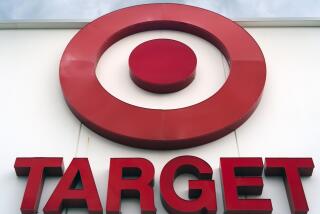Target plays catch-up in removing gender-based toy labels
- Share via
The toy aisle is getting a gender-neutral makeover.
Target Corp. is the latest retailer, following Wal-Mart Stores Inc. and Toys R Us Inc., to start removing gender-based labels from its toy shelves.
The Minneapolis-based retailer said children’s bedding and toy aisles will now be marked with the universal term “kids” instead of “boys” and “girls.” Target also said it would remove the pink, blue, yellow and green paper on the back of its toy shelves, which also referred to gender. It will be replaced with a neutral wood grain tone paper, said Molly Snyder, Target spokeswoman.
Target said guests have indicated in the past that signs sorting items by brand, age or gender can help them find products faster.
“But we know that shopping preferences and needs change,” the company said in the blog post Friday. “As guests have pointed out, in some departments like Toys, Home or Entertainment, suggesting products by gender is unnecessary.”
In June, Ohio mom Abi Bechtel tweeted a photo of a Target sign that listed “Building Sets” and “Girls’ Building Sets,” and said, “Don’t do this, @target.” The picture was retweeted more than 2,000 times.
Over the last few years, the toy industry has gravitated away from gender-specific labeling, said Jim Silver, chief executive and editor-in-chief of TTPM, a toy review site for consumers.
“The labeling of boys and girls toys is slowly disappearing,” he said. “There’s definitely more crossover appeal than there was 10 years ago.”
He added that many retail stores will categorize aisles by product, like an action figure aisle or a doll aisle, rather than specifying gender. For instance, Wal-Mart tries to maximize its space by putting two to three categories in one aisle, and may have a game wall. Toys R Us also categorizes its products.
“Retailers, for the most part, have been doing this for a pretty long time,” Silver said.
For Target, “this is a little bit of playing catch-up,” he said.
The trend extends beyond the U.S. to Britain and Australia, said Elizabeth Sweet, a lecturer in the sociology department at UC Davis who wrote her dissertation on toys, gender and inequality.
“I think what is happening with Target plays into a much larger global movement,” she said.
Tom Meyvis, a professor of marketing at New York University’s Stern School of Business, said removing gender labels from toys gives more power to the consumer, a trend in marketing.
“To some extent, you give more control to the customer,” he said. “So customers can decide for themselves what is the ideal product for their son or daughter, rather than being told this is the category your child falls into.”
Target said the changes would happen over the next few months and that it would identify other areas where gender-based signs were unnecessary.
For more business news, follow @smasunaga.
More to Read
Inside the business of entertainment
The Wide Shot brings you news, analysis and insights on everything from streaming wars to production — and what it all means for the future.
You may occasionally receive promotional content from the Los Angeles Times.











